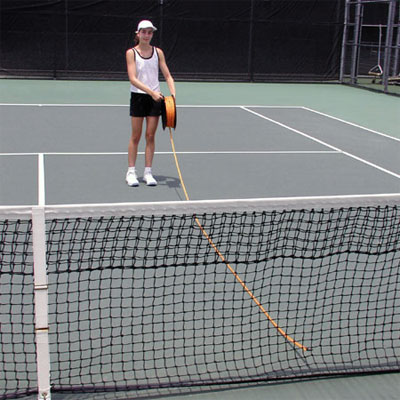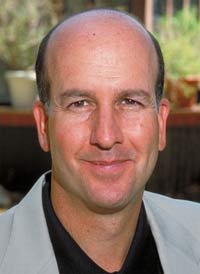|
TennisOne Lessons The Art of Target Practice Targeting: Failing to Aim = Aiming to Fail Joe Dinoffer Target is more than a name of a major department store chain, In fact, hundreds of times each day, we are influenced by visual targets concealed as “guidance systems” without even thinking about it. What are some daily life examples? Here are ten examples:
In tennis, the “target” is the other side of the net, an area as wide as most houses and hard to miss. However, there’s more to tennis than just getting the ball over the net and inside the lines. But not all players hit with specific targets in mind. It may sound funny but frequently when a weekend warrior hits a winner, knowledgeable onlookers can tell that the player wasn’t aiming at anything in particular in the first place! During my three decades of full time tennis teaching, I have said to many players, “Great shot!” and then asked them, “But, tell me the truth, did you hit that target on purpose?” Besides not aiming at all, there are a handful of other targeting goals to aim for. TARGET GOAL #1: Set up achievable targets
We’ve all “been there, done that” on a tennis court. You are taking a lesson or perhaps practicing your serve by yourself, and you set up a can of balls or a single cone and start trying to hit it. You quickly realize that hitting a small target from 60 feet away is unfortunately very difficult. The result is what I call “negative visualization.” This means that when you fail to succeed at hitting a visual target reference, it will be a negative experience with little or no lasting value gained from the practice. On the other hand, if you set up a target area that you can successfully strike about 70% of the time, your experience will lead to “positive visualization.” When that target area is the right size for your skill level, you will still have to concentrate your efforts, but you will be successful. But, bull’s-eye targets are not all bad. Inside the larger target area, set up a bull’s-eye as well. Just understand that while you may be aiming for the bull’s-eye, you are succeeding when you hit the ball within the larger target area. If you happen to hit the cone or can of balls inside the target zone, consider it a combination of skill and luck! Realize that your real success is consistently hitting a high percentage of balls inside the larger target area you have created. TARGET GOAL #2: Correct your mistakes
Is there such a thing as a good mistake? Yes! Focusing on the bull’s-eye within your larger target area zone is the key to avoiding Target Error #2. But there’s a little more to keep in mind. Since we know we will not hit the actual bull’s-eye, there will be four possible mistakes we can make. Hitting too far, too short, to the right of the target, or to the left. Just like everything in life, we want to be aware of our mistakes and make adjustments to compensate. On a tennis court, be aware of where your shots land and try hard not to make the same mistake two times in a row, and certainly hardly ever three times in a row. So, if you hit too short on one shot, try to hit deeper and a little past the bull’s eye target on the next one. How? Either increase the arc of the ball or increase the ball speed. It’s important to note that both shots should still land within the larger target zone that you have established. TARGET GOAL #3: Steer clear of the lines Just like driving a car within your lane on a crowded highway, you want to also stay clear of the lines on a tennis court. We were just reminded that no one can hit bull’s-eye targets consistently. Setting up the target in the correct location is also very important. Why? Because we need to leave ourselves a margin for error appropriate to our skill level. A common mistake is for players to aim too close to the lines. The result is not only missing your target but hitting outside the lines of the court, resulting in too many unforced errors. You already know that (if you are practicing properly and challenging yourself to improve) you will miss your skill-appropriate target areas about 30% of the time. But missing your target area does not mean you need to lose the point on that shot. Create your target areas far enough from the sidelines and baseline so your mistakes keep you in points and not out of them. TARGET GOAL #4: Develop a variety of target areas
Another big error players make is to only have two targets. Think about it. If your opponents know that you never hit drop shots or short angles, they can park themselves behind the baseline and be content to rally with you all day long. It would be like the player who never lobs. What should you do tactically if you play someone who never ever hits a lob? Get to the net and close in as much as you can. You will win more points than you ever dreamed possible. Likewise, if you are a steady baseliner and you know your opponent tries to hit only down the line or cross court and deep, you should be similarly happy. Just hang back and be comfortable as a steady baseliner, knowing that your opponent is playing right into your strength. TARGET GOAL #5: Recognize your skill level You may be surprised to hear this, but there are plenty of 3.5 level players who can beat players who consider themselves 4.5. Those effective 3.5 players may not “look” as good as their 4.5 counterparts and they may not have as much shot variety in their toolbox, but they would nevertheless be victorious. Too many players who think they are better than match results may show, are impatient and set out to hit too many winners. The results are not surprising. These players hit far too many unforced errors. The late great tennis teaching legend Vic Braden once said, “Losers have tons of variety. Champions take pride in learning to hit the same old boring winning shots.” What can we learn from this? At all levels, aim for bigger targets, make fewer errors, and never get bored hitting the same shot again and again and again (as long as you can perform that particular shot better than your opponent!). Summary? One of the keys to visualization training (using targets as a guide) is to integrate a practice called “fading.” This means that you practice with your visual target in place (ropes, cones, etc.) and then, when you “fade” or take the target area away, you will still be able to visualize the target you are aiming for. In short, if you fail to to aim, you will be aiming to fail. It’s that simple.
Your comments are welcome. Let us know what you think about Joe Dinoffer's article by emailing us here at TennisOne.
Joe Dinoffer is among 10 master professionals in both the USPTA and PTR. He was also awarded the USPTA National Industry Excellence Award as well as Texas Division Pro of the Year. He has written and produced 7 books and 22 DVDs and has appeared numerous times on the Tennis Channel. Joe is also the founder and President of Oncourt Offcourt, Ltd., a tennis company recognized as one of the most creative in the industry. See his work at www.OncourtOffcourt.com. |

 Joe Dinoffer
Joe Dinoffer